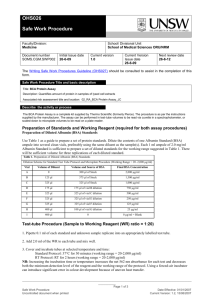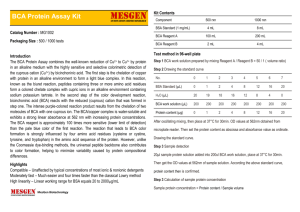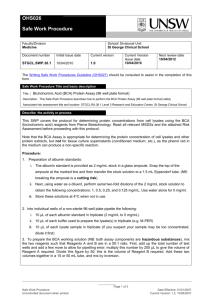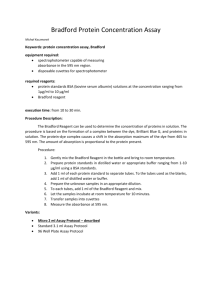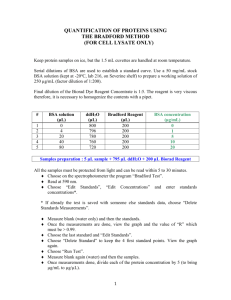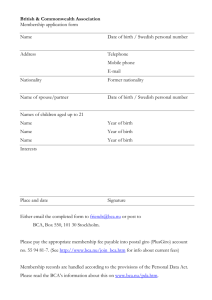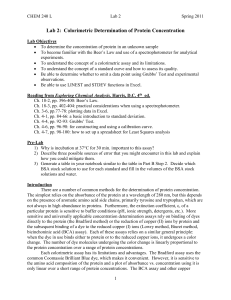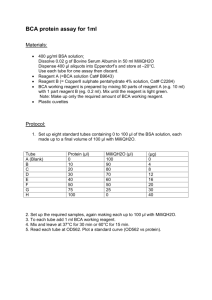BCA Protein Macro Assay Kit - SERVA Electrophoresis GmbH
advertisement
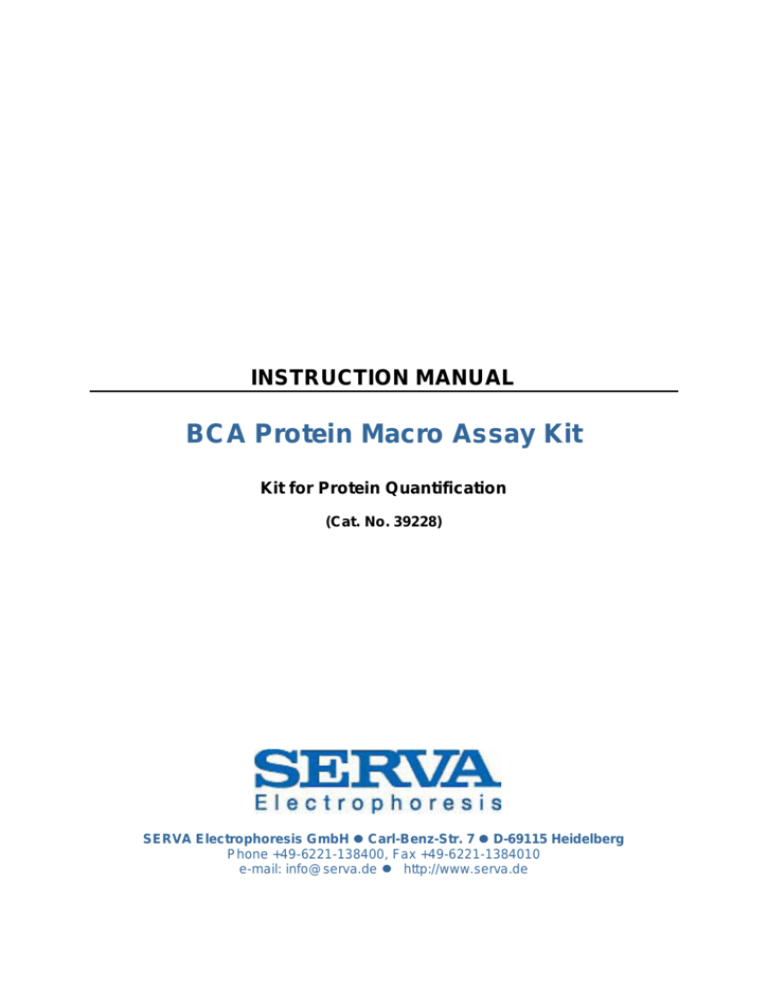
INSTRUCTION MANUAL BCA Protein Macro Assay Kit Kit for Protein Quantification (Cat. No. 39228) SERVA Electrophoresis GmbH Carl-Benz-Str. 7 D-69115 Heidelberg Phone +49-6221-138400, Fax +49-6221-1384010 e-mail: info@serva.de http://www.serva.de Contents 1. 2. BCA PROTEIN MACRO ASSAY KIT 2 1.1. General information 2 1.2. Kit components 2 1.3. Additionally required equipment 2 1.4. Storage conditions 3 PROCEDURE OF THE BCA ASSAY 3 2.1. Preparation of standards and reagents 2.1.1. BSA Protein standard 2.1.2. BCA working reagent (BWR) 3 3 3 2.2. Preparation of BSA reference solutions 3 2.3. Protein quantification procedure 4 2.3.1. 4 Protocol 2.4. Calculation of protein concentrations 5 2.4.1. Creation of the calibration curve 5 2.4.2. Calculation of the protein concentration 6 3. LITERATURE 7 4. TROUBLESHOOTING 8 Vers. 07/10 1 1. BCA Protein Macro Assay Kit 1.1. General information The bicinchoninic acid (BCA) based protein assay is a most sensitive and detergent compatible method for the colorimetric detection and quantitation of total protein. This method is a combination of the well-known Biuret reaction, the reduction of Cu2+ to Cu1+ by protein in an alkaline medium, and the highly sensitive and selective colorimetric detection of the cuprous cation (Cu1+) with a bicinchoninic acid containing reagent. The purple-colored reaction product of this assay is formed by the chelation of two molecules of BCA with one Cu1+ ion. This water-soluble complex shows a strong absorbance at 562 nm. BCA-Protein Reaction 1. Protein (peptide bonds) + Cu2+ • Cu1+ Biuret complex 2. Cu1+ + 2 Bicinchoninic Acid • 562 nm). BCA-Cu1+ complex (purple colored, read at The SERVA BCA Assay kit contains well standardized reagents which give a linear increase in the reaction product at 562 nm with increasing protein concentrations over a broad range from 25 µg/ml to 1,000 µg/ml. The macromolecular protein structure, the number of peptide bonds and the presence of four amino acids (cysteine, cystine, tryptophan and tyrosine) are reported to be responsible for color formation with BCA. 1.2. Kit components Component Cat. No. 39228.01 (250 Assays) Cat. No. 39228.02 (500 Assays) 500 ml 2 x 500 ml 10 ml 20 ml 10 x 2 mg 20x 2 mg Reagent A: BCA Solution Reagent B: Copper Sulfate Solution Protein Standard (Bovine Serum Albumin) BSA 1.3. Additionally required equipment • Vortex mixer • Photometer suitable for measurement at 562 nm wavelength and the usage of microcuvettes • Plastic cuvettes 2 1.4. Storage conditions The recommended storage temperature for the BCA Protein Macro Assay Kit is +2 – +8 °C. Under these storage conditions the unopened reagent is at least useable until: see expiry date on the label. 2. Procedure of the BCA Assay 2.1. Preparation of standards and reagents 2.1.1. BSA Protein standard Tap the powder in the standard vial to the bottom and add 1 ml of water containing 0.05 – 0.1 % sodium azide. The BSA stock solution (2.0 mg/ml) can be stored at 4 ºC for two weeks. Prepare a fresh set of protein standards by diluting the BSA stock solution, preferably in the same diluents as your sample. Please refer to 2.2. for details about dilution of the BSA stock solution. One vial of BSA Standard is sufficient to prepare three sets of diluted standards. 2.1.2. BCA working reagent (BWR) To prepare BWR, mix 50 parts of Reagent A with 1 part of Reagent B. When Reagent A is initially added to Reagent B, a turbidity is observed that quickly disappears upon mixing to yield a clear-green BWR. Prepare sufficient volume of BWR based upon the number of tests to be done. Each test tube sample to be done requires 2 ml of the BWR. BWR is stable for at least 1 day when stored in a closed container at room temperature (RT). 2.2. Preparation of BSA reference solutions Final BSA Concentration [µg/ml] 1000 (A) 750 (B) 500 (C) 250 (D) 100 (F) 50 (G) 25 (H) Volume BSA [µl] 750 (Stock solution) 375 (A) 250 (A) 125 (A) 50 (A) 25 (A) 12,5 (A) 3 Volume Diluent [µl] 750 125 250 375 450 475 487,5 2.3. Protein quantification procedure Each of the commonly used total protein assay methods exhibit some degree of varying response toward different proteins. These differences relate to amino acid sequence, pI, protein structure and the presence of certain side chains or prosthetic groups that can dramatically alter the protein’s color response. Most protein assay methods utilize BSA or immunoglobulin G (IgG) as standard against which the concentration of protein in the sample is determined. The following substances have been reported to interfere with the accurate estimation of protein concentration with the BCA Reagent. They should be avoided as components of the sample buffer. Ascorbic Acid Cysteine Hydrogen peroxide Lipids Impure Sucrose Uric Acid Catecholamin EGTA Hydrazides Melibiose Tryptophan Creatinine Impure Glycerol Iron Phenol Red Tyrosine 2.3.1. Protocol • Pipet 0.1 ml of each standard or unknown sample into appropriately labeled test tubes. Use 0.1 ml of the diluent for the blank tubes. • Add 2.0 ml of the BWR to each tube, mix well. • Incubate all the tubes at the selected temperature and time: Standard Protocol: 37 °C for 30 min Enhanced Protocol: 60 °C for 15 min • After incubation, cool all tubes to RT. • Measure the absorbance at 562 nm (A562nm) of each tube vs. a water reference. Note: Because the BCA Reagent does not reach a true end point, color development will continue even after cooling to RT. However, because the rate of color development is low at RT, if the A562nm readings of all the tubes can be done in 10 minutes or less, no significant error is introduced. • Subtract the average A562nm reading of the blanks from the A562nm reading for each standard or unknown sample. • Prepare a standard curve by plotting the average blank corrected A562nm reading for each BSA standard vs. its concentration in µg/ml. Using the standard curve, determine the protein concentration for each unknown sample. 4 Flowchart: Pipet 100 µl dist. H2O and buffer for blank, reference solutions and samples into test tubes Add 2 ml BCA working reagent Mix by vortexing Incubate according to the standard or modified protocol Let the tubes cool down to RT Transfer solutions to cuvettes Measure absorbance at 562 nm (A562nm) 2.4. Calculation of protein concentrations 2.4.1. Creation of the calibration curve Create a table with the absorbance results obtained from the assay. From the values obtained for the BSA reference solutions create a calibration curve which is used to determine the protein concentration in the unknown sample. Figure 1: Example of BSA calibration curve (incubation 30 min at 37 °C) 5 2.4.2. Calculation of the protein concentration • Construct a calibration curve by plotting optical density reading on y-axis against standard protein amount (µg/tube) on the x-axis • Record the value x for the protein amount per tube from the calibration curve corresponding to the optical density reading for inividual sample. • Calculate the sample concentration (C) by using the following formula: X [µg] / V [µl] = C [µg/µl] = C [mg/ml] X: protein amount of the sample V: sample volume used in the assay • Correct for predilution of samples if any by using the following formula: (X [µg] / V [µl]) * DF = C [µg/µl] = C [mg/ml] X: protein amount of the sample V: sample volume used in the assay DF: dilution factor 6 3. Literature Smith, P.K., Krohn, R.I., Hermanson, G.T., Mallia, A.K., Gartner, F.H., Provenzano, M.D., Fujimoto, E.K., Goeke, N.M., Olson, B.J. and Klenk, D.C (1985). Measurement of protein using bicinchoninic acid. Anal. Biochem. 150, 76-85. Wiechelman, K., Braun, R. and Fitzpatrick, J. (1988). Investigation of the bicinchoninic acid protein assay: Identification of the groups responsible for color formation. Anal Biochem. 175, 231-237. Brown, R., Jarvis, K. and Hyland, K. (1989). Protein measurement using bicinchoninic acid: elimination of interfering substances. Anal. Biochem. Peterson, G.L. (1979) . Review of the folin phenol protein quantitation method of Lowry, Rosebrough, Farr and Randall. Anal. Biochem. 100, 201-220. Kirschbaum, G. (1986). Use of the bicinchoninic acid assay in measuring urinary proteins. Clin. Chem. 32, No. 3, Letter to the Editor, 572. 7 4. Troubleshooting • The presence of incompatible substances in the sample Interference in the BCA Protein Assay may be eliminated or overcome by: a. Removing the interfering substance by using the SERVA BluePrep kits, e.g. DetergentEx or CBD, as well as dialysis or gel filtration. b. Diluting the sample to the point that the substance no longer interferes. (Can only be done if the starting protein concentration of the sample is high.) c. Precipitating the proteins in the sample with acetone or trichloroacetic acid (TCA); the liquid containing interfering substances is discarded and the protein pellet is easily solubilized directly in the BWR. d. Increasing the amount of copper in the BWR may eliminate interference by copper chelating agents. Note: For higher accuracy of the estimate of protein concentration in the sample, the protein standards must be treated identically to the sample. • Reading at wavelengths other than 562 nm If a photometer or plate reader with a 562 nm filter is not available, the purple color may be measured at any wavelength between 540 nm and 590 nm. The maximum absorbance of the BCA-Cu1+ complex occurs at 562 nm. Taking the absorbance measurements at any wavelength other than 562 nm will result in a lower slope for the standard curve and may increase the minimum detection level for the protocol. • Cleaning and re-use of glassware Care must be exercised when re-using glassware. The BCA Reagent is sensitive to metal ions, especially copper ions. All glassware must be cleaned and then given a thorough final rinse with high-quality deionized water. 8

